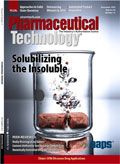Ideas Know No Borders
As technology advances, industry's needs are growing.
Many times, when we speak of "an increasingly global field," we immediately think of business models, outsourcing, and regulation. Certainly, these are aspects of our industry, but they don't represent the complete picture of what it means to interact globally in the pharmaceutical sciences. International collaboration starts with ideas, and the exchange of those ideas between scientists that were once a world apart, but that are now, for many reasons, closer to each other than ever before.

Danny D. Shen, PhD
At the American Association of Pharmaceutical Scientists (AAPS), we strive to be a dynamic international forum for the exchange of knowledge and ideas among scientists. It is this exchange of ideas that I'm looking most forward to during this month's International Pharmaceutical Federation (FIP) Pharmaceutical Sciences World Congress (PSWC) in association with the AAPS Annual Meeting and Exposition. A meeting like the PSWC is just one way that experts from various disciplines and sectors meet to find idea-based, technological solutions to some of the challenges that accompany the opportunities presented to us.
One of industry's current challenges is the fight against counterfeit drugs. It is extremely important that patients be confident in knowing that the medication they are taking is safe and effective. Traditional methods of identification such as inks and packaging systems have helped in this battle, but there are also newer technologies that may hold a great deal of promise. For example, the US Food and Drug Administration's physical-chemical identifiers (PCID) guidance and its potential application in manufacturing may give the industry a new tool in combating counterfeit strategies.
Of course, methods to prevent counterfeiting, in and of themselves, can produce additional challenges for drugmakers, who many times have intellectual property concerns to consider. There is no silver bullet in the fight against counterfeiting, but a robust discourse among all stakeholders on cost-effective strategies that can help keep safe medicines in the marketplace and counterfeit medicine out is necessary if we are to do right by the patient.
Another moving front in pharmaceutical technology is the adoption of continuous manufacturing, which dovetails with the application of process analytical technology and quality-by-design concepts. Continuous manufacturing holds the promise of more integrated and efficient processing. When continuous processing is successfully applied to existing pharmaceutical manufacturing, it makes it increasingly likely that these technologies will be deployed with new products. The cost of investment and adaptation to new regulations are significant hurdles for manufacturers to move fully toward continuous operations. However, by conducting cost:benefit analyses and evaluating implementation options, we can facilitate communication between stakeholders and help move our manufacturing practice in more efficient directions.
Of course, I can't talk about advancing technologies in the pharmaceutical sciences without discussing the ever-growing field of biotechnology. Advances in natural and synthetic technologies, including plant-based chemistry, and synthetic peptides and small proteins are expanding the repertoire of biotechnology based therapeutics. At the same time, these advances continue to challenge the development and manufacturing of diverse therapeutic entities. At AAPS, we've recognized the growing importance of biotechnology and have responded by increasing our educational offerings in this area, including a new educational online series that will be unveiled soon. This series is one of the charges of our Education Task Force, which is aligning AAPS educational offerings to meet the changing needs of our members.
Great ideas know no borders—and that's great news as we embark on a new decade. That is why when we come together in New Orleans this month to discuss new technologies and ways to implement them, we do a great service to ourselves as scientists, our businesses and organizations, and most importantly to the patients that depend on the medicines we provide. One thing we keep reminding ourselves of at AAPS is that our global collaboration begins at this meeting; it is not a culmination. The constant flow and exchange of ideas at meetings, workshops, webinars, and other communicative means is what will drive the future of our industry, because translating ideas into products uses the latest and best technology that we have available.
Danny D. Shen, PhD, is president of the American Association of Pharmaceutical Scientists (AAPS).

Pharmaceutical Tariffs Are Imminent: How Industry is Bracing for Impact
April 16th 2025On April 14, 2025, the Trump Administration launched a national security-driven investigation into pharmaceuticals, a move that will likely result in tariffs being placed on pharmaceutical drugs, ingredients, and other components that are imported from outside of the United States.